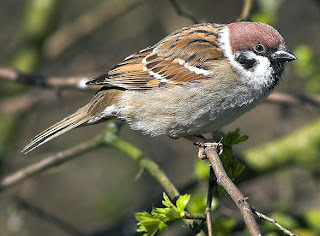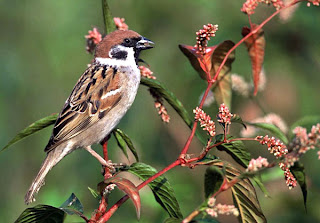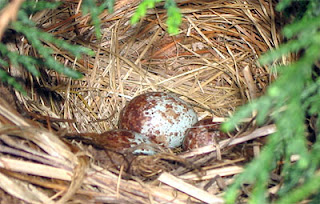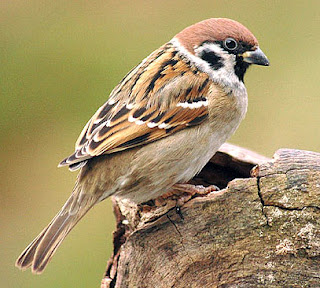Characteristics
Smaller than a House Sparrow, the Tree Sparrow is an active bird, with its tail almost permanently cocked. The adult’s crown and nape are rich chestnut, and on the white cheeks and ear-coverts there is a triangular black patch; the chin and throat are black. Two distinct though narrow white bars cross the brown wings. In summer the bill is lead-blue, and in winter almost black. The sexes are practically alike.
 The young, even in the nest, closely resemble their parents. They are said to be duller, and the face pattern is less distinct. The breast and belly are browner than in the adult.
The young, even in the nest, closely resemble their parents. They are said to be duller, and the face pattern is less distinct. The breast and belly are browner than in the adult.
Habitat
Though occasionally nesting in isolated trees, it is a social bird at all seasons, and a grove of old trees with a plentiful supply of hollows, or a disused quarry, are favourite sites for the colony. What it likes is a hole in which to put its untidy nest, composed of hay, grass, wool or other material and lined with feathers.
 Some of the nests are not actually in holes in rock, but are built among roots of overhanging furze or other bushes. A domed nest is sometimes built in the old nest of a Magpie or other bird.
Some of the nests are not actually in holes in rock, but are built among roots of overhanging furze or other bushes. A domed nest is sometimes built in the old nest of a Magpie or other bird.
 They usually lay four to six eggs, which vary considerably, and frequently the markings are massed at one end. In most clutches one egg is lighter and differs in markings from the others.
They usually lay four to six eggs, which vary considerably, and frequently the markings are massed at one end. In most clutches one egg is lighter and differs in markings from the others.
 Behaviour
Behaviour
They are shyer than house sparrows in the UK and are not associated with man, although in continental Europe they nest in buildings just like house sparrows.
The Tree Sparrow’s voice is quite shrill; the call is a short ‘chip’, and the song, consisting of modulated chirps, is musical.
B.A.B.










